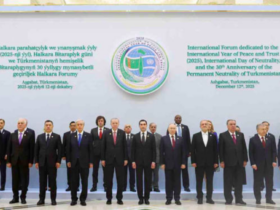By Orçun Göktürk – Beijing / China
In an effort to stimulate recovery in the Chinese economy post-COVID-19, a series of policies have been implemented, such as strongly promoting the development of the private economy, increasing foreign investment, reducing loan interest rates, boosting demand for home purchases, revitalizing the capital market, and lowering the reserve ratio for deposits.
In China, those who traditionally advocate for a planned approach to guiding the economy refer to this process with the Chinese idiom “yǐn zhèn zhǐ kě” (饮鸩止渴), which can be translated “drinking poison to quench thirst.” During this period, concepts from the “Reform and Opening-Up” initiated under Deng Xiaoping have also started to be frequently used. These include “deepening reform and opening-up,” “accelerating the implementation of market-oriented, rule of law-based, and internationalized reform initiatives,” and “further promoting market vitality and social creativity.”
However, it appears that these measures will have little effect. This is due to the overproduction and overcapacity issues China has faced since the major financial crisis of 2008, which has become the fundamental contradiction of the Chinese economy. This contradiction lies not on the supply side but in demand constraints, the lack of effective demand with purchasing power. This should not be interpreted as opposition to savings. Most of the measures taken to stimulate economic revival are still grounded in a “supply-side structural reform” mindset, which not only fails to resolve this major contradiction but could also push the Chinese economy into a long-term phase known as “L-growth.”
Promoting the private economy…
If we examine the internal contradictions of the Chinese economy, exacerbated by the global economic slowdown, the main contradiction lies in the strategy of “promoting the private economy.” The biggest problem of the Chinese economy is the lack of effective demand for final consumption with purchasing power. Naturally, can the strong promotion of the private economy address this problem? Frankly, no.
The rhetoric that “private enterprises have made a significant contribution to the rapid growth period of the Chinese economy,” repeated for years by both Western liberal doctrine and its proponents in China, has created a major illusion. Of course, the contribution of the private sector to the economy under the strict control of the state and the Communist Party of China (CPC) is significant. However, the process has reached a turning point due to the contradictions it has created within itself. Now the questions to ask are: When the Chinese economy is in recession, how can it be said that the development of private enterprises is insufficient, and that the business environment is not favorable? Is it possible that the private economy is in a worse state than during the period of rapid growth? Is the current economic downturn due to the government’s policy towards the private sector?
“Visible hand” solution to crises in the West
If the strong development of private enterprise could solve the current challenges of the Chinese economy, why did the United States only emerge from the “Great Depression” of the 1930s thanks to Roosevelt’s “New Deal” and the significant increase in national fiscal deficit during World War II? Moreover, almost all major enterprises in the U.S. during the Great Depression were privately owned! In other words, even the metropolitan countries of capitalism resorted to “more state” to escape the situation.
Since the end of 2008, the Chinese economy has been in a much better position than during the Great Depression of the 1930s in the West, but the nature of the problem is similar: insufficient effective demand and overproduction relative to the purchasing power of money. When viewed in this context, no Western country, starting with the U.S. during the Great Depression, took a path of addressing the economic crisis by increasing private enterprise. Quite the opposite; the liberal doctrine was turned upside down, and the mighty power of the state returned to the economy. The myth of the “invisible hand” was shattered. No Western country adopted “supply-side structural reform” policies like “reducing excess production capacity” and “clearing inventories,” as such “market-clearing” ideas could have bankrupted many businesses and worsened unemployment. All Western capitalist countries emerged from the Great Depression by intervening in the market with state power to address the demand problem.
Moreover, a similar approach was adopted against the 2008 Global Financial Crisis. In response to the collapse of Lehman Brothers, which triggered the crisis in the U.S., a budget of $700 billion was allocated solely for the “Troubled Asset Relief Program” from the central budget, and $831 billion was allocated under the “American Recovery and Reinvestment Act.” The state again stepped in to heal the wounds inflicted by the economic crisis, shaped by the ruthless rules of the market.
Will a supply-side focus solve the problem?
In response to the 2008 global financial crisis, the Chinese State Council announced an “economic stimulus plan” and prepared a stimulus package worth 4 trillion RMB (about $587 billion at the then-current exchange rate). The economic stimulus plan was successful, and by the end of 2008, when China’s economic growth fell to 6%, it returned to double digits in 2009, exceeding 10%. The issue was correctly diagnosed as “lack of demand,” and an appropriate remedy was applied. However, this economic policy, due to significant flaws, also triggered new policy changes: a shift from the demand side to the supply side. Consequently, the tightening on the supply side has become one of the major factors in the continuous downward trend in the Chinese economy over the past decade. In recent years, economic policies aimed at promoting economic recovery in China have still largely been guided by a “supply-side structural reform” strategy, leading some Chinese experts to warn that “China could face the risk of chronic economic stagnation.” Without addressing the problem of insufficient effective demand for final consumption, any attempt to promote the private economy will be ineffective.
Looking at the recent economic measures taken in China, it seems that the government is trying to stimulate markets with gradual and smaller-scale measures instead of direct large-scale spending plans. Whether these policies will be effective in overcoming a potential recession remains to be seen.

















Leave a Reply